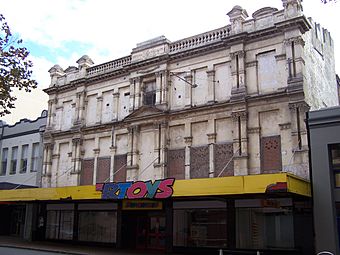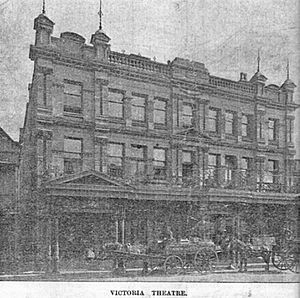Victoria Theatre (Newcastle) facts for kids

Victoria Theatre, 2007
|
|
| Address | 8–10 Perkins Street Newcastle Australia |
|---|---|
| Coordinates | 32°55′43″S 151°46′39″E / 32.92866°S 151.77752°E |
| Designation | Historic building |
| Type | Dual purpose theatre/cinema |
| Current use | Vacant |
| Construction | |
| Opened | 1876 |
| Closed | 1966 (as theatre) |
| Rebuilt | 1890/91, 1921 |
| Years active | 1876–1966 as theatre 1921–1966 as theatre/cinema 1966–1997 Retail space |
| Architect | J. Henderson |
The Victoria Theatre is a very old building in Newcastle, Australia. It was once a famous theatre and cinema. It first opened in 1876 and was rebuilt in 1890–1891. This makes it the oldest theatre building still standing in New South Wales. It's considered a special heritage site.
The Victoria Theatre is one of many large theatres built in Newcastle from the 1870s. These theatres showed both live stage shows and movies. Most of them have now closed down.
Contents
A Look Back: History of the Victoria Theatre
The first Victoria Theatre was built in 1876. It was changed in 1885 and then completely pulled down in 1890. A new, bigger Victoria Theatre was built in 1890. It kept showing movies until 1966.
Early Days and Grand Rebuilding
In its early years, the theatre hosted exciting acts. These included acrobats and opera companies. They performed famous operas like Lucia di Lammermoor and Faust.
In 1886, a group of important people, including the mayors of Newcastle and Maitland, decided to buy the theatre.
The theatre was greatly rebuilt in 1890. The architect, Mr. James Henderson, designed a beautiful three-level hall. It had a Greek-style look. The new theatre could seat 1,700 people. It also had a large stage and a small hotel. The stage was about 14 metres wide, 12 metres deep, and 17 metres high.
In 1897, the theatre held a special concert for the Governor and his wife. In June of that year, the city celebrated Queen Victoria's long reign. The theatre was lit up brightly. A picture of the Queen was shown on the front. A band played music outside. People also watched "Flying Jordons American Vaudeville Athletes" and saw a new invention, the Lumeire Cinematographe (an early movie projector). Later, Professor D M Bristo brought his performing horses, ponies, and mules to the stage!
In 1905, the theatre was updated again. More dressing rooms were added, and the stage was made wider.
From Stage to Screen
Many Australian plays were performed here. These included Thunderbolt (1906) and On Our Selection (1913).
In November 1913, a big boxing match happened at the theatre. The famous boxer Les Darcy fought Bob Whitelaw. In 1914, a charity show of Romeo and Juliet was held to raise money for Newcastle Hospital. Madam Schell's amazing Lions also appeared that year.
Later, laws about hotels changed. So, in 1921, the theatre was renovated to be both a stage for live shows and a cinema. The upper balcony and hotel were removed. The theatre was made more suitable for showing movies. An artist named Norman Carter painted beautiful Greek murals inside.
In 1922, Sir Benjamin and John Fuller took over the Victoria Theatre. They added it to their national chain of live theatres. This brought many famous theatre companies to Newcastle. These included J. C. Williamsons and the Australian Elizabethan Theatre Trust. Famous performers like Sir Harry Lauder (in 1925) and Gladys Moncrieff (in 1928) visited. The theatre also hosted an expensive Italian Opera Festival in 1928–29.
The Victoria Theatre also became a popular place to watch movies. Companies like Hoyts showed films there. Some famous movies included Gone With The Wind and Snow White and the Seven Dwarfs.
Live shows continued into the 1950s and 1960s. People saw ice skating shows, musicals like Oklahoma! and The Sound of Music, and famous singers like Joan Hammond and June Bronhill.
Closing and Future Plans
After 90 years, the theatre quietly closed in 1964. The last film shown was Who's Buried in my Grave. The stage equipment was left in place, hoping it might reopen for live shows one day.
After closing, parts of the theatre were changed into shops. It was bought by W. Eastham in 1966 and became Eastham's Theatre Store. Later, it was a toyshop called Supertoys. In 2015, Century Venues bought the building. They own the Enmore Theatre and plan to restore the Victoria Theatre to its former glory.
What the Victoria Theatre Looks Like
The front of the Victoria Theatre is very decorative. It has a Victorian style with smooth and shaped plaster. It features classical designs. The front has a ground floor that has been changed over time for different shops. Above the awning, there are two levels with columns and decorative bands. The very top has a fancy fence with the theatre's name.
The front also has "blind windows." These look like windows but are actually solid walls. They show that the building is a theatre, designed to keep daylight out.
Inside, many parts of the theatre are still original. This includes the dress circle (a seating area), the stage, and the dressing rooms. Only the entrance area and the back of the main seating area were changed for shops. The outside above the awning is also mostly the same as it was after the 1921 changes.
Experiencing the Past: Virtual Reality
In 2018, the inside of the Victoria Theatre was brought back to life using virtual reality. Staff from the University of Newcastle recreated what it looked like in 1891. People could explore the different areas, like the foyers, seating, and stage, as if they were really there.
Why the Victoria Theatre is Important
The Victoria Theatre is very important for the history of New South Wales. It is the oldest theatre building still standing in the state. It shows us what silent movies, vaudeville (a type of variety show), and early live theatre were like over 100 years ago.
Even though some parts were changed for shops, most of the theatre is still intact. This means it still has its 1891 front and parts of its 1891 and 1921 interiors. It also has large backstage areas. It's a key part of Newcastle's history and a significant building for all of New South Wales.
The Victoria Theatre is listed on the New South Wales State Heritage Register because:
- It shows how cultural history developed in New South Wales. It's the oldest theatre building still standing. It was used by major Australian theatre companies and for early Australian films.
- It has beautiful design and creative achievement. The Victorian front is an important part of the street. The inside design from 1921 is unique, with simple classical styles.
- It has a strong connection to the community. For about 80 years, the Victoria Theatre was a very important place for entertainment and social events in Newcastle. Many older people still remember the live shows they saw there.
- It is rare and uncommon. It is the oldest theatre building still standing in New South Wales.
Images for kids




